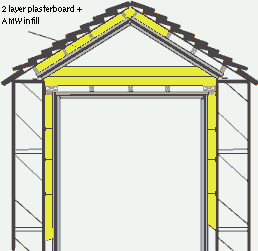The first things you should consider when wanting to convert a domestic garage into a music studio or practise room is that it will be extremely difficult, in such a small space, to achieve a completely soundproof structure so, in a residential situation where the garage is situated close to neighbouring properties, 24-hour a day use may still not be possible.
If background noise levels outside the garage are low then the neighbours are more likely to still hear sound escaping than if the garage is situated near to constant road noise. If the garage itself is connected to your house (or even worse your neighbours house!) then structure bourne noise transmission could be worse than sorting out the airborne sound transmission.
Often, when people convert these sorts of spaces they forget to consider that the existing ceiling structure probably provides much less soundproofing capability than the roof. A simple tiled wooden roof will need more reinforcing than say plastered block walls. The door, and any windows, will also be a major weak point to start with. These things should be addressed first because sound will always find its way through the weakest part of the chain. Ideally any windows and doors should be bricked up. If an 'up and over' type door has to remain then consider adding a hidden brick wall behind the door. Alternatively, but not ideal, would be to add some soundproofing mat to the back of the door and seal it shut with mastic. A stud wall will still ideally need to be built behind it.
If you really want to convert your garage you really don't want to be doing it to a lightweight single clad structure. It's best to start with at least a garage with walls constructed from dense brickwork/blockwork and preferably plastered. In order to obtain further improvement in insulation an inner lining comprising two layers of 12.5mm plasterboard, sandwiching a layer of soundproofing mat, on 75mm timber studs should be built with the cavity behind the plasterboard being filled with acoustic mineral wool. If your garage has a pitched roof, supported on timbers then the sound insulation of the roof system can be improved by lining the pitched roof underneath with additional plasterboard/soundproofing mat and installing acoustic mineral wool in the space between the plasterboard and the roof decking.

A second flat ceiling should then be built using plasterboard and soundproofing mat with a double layer of acoustic mineral wool insulation fitted in the roof space. When completed the inside of the room will need some acoustic absorption to create a non reverberant acoustic space. This will also further help reduce the amount of noise that is trying to escape to outside.
It should also be remembered that when finished the room will be acoustically sealed so ventilated can be an issue. Unless you are prepared to open the doors regularly then it may be neccessary to install some wall mounted inlet and outlet fresh air ducting.
Fig1 very basically shows what you need to achieve. Please remember that this article just contains an outline of methods that can be used. Whether or not the level of improvement will be adequate will depend many factors such as the amount of noise generated within the garage, the background noise level in the area and the distance between the garage and the nearest neighbour. Loud amplified music which contains a lot of bass can be very difficult to isolate and most soundproofing tends to be reduced at lower frequencies. It is also beneficial if the inside structure is totally isolated from the existing shell rather than tied to it (i.e. a room within a room).